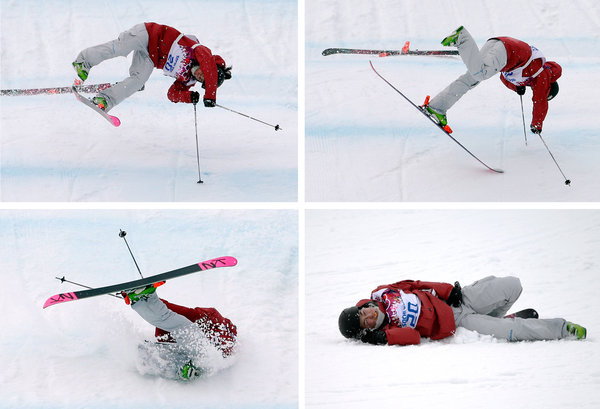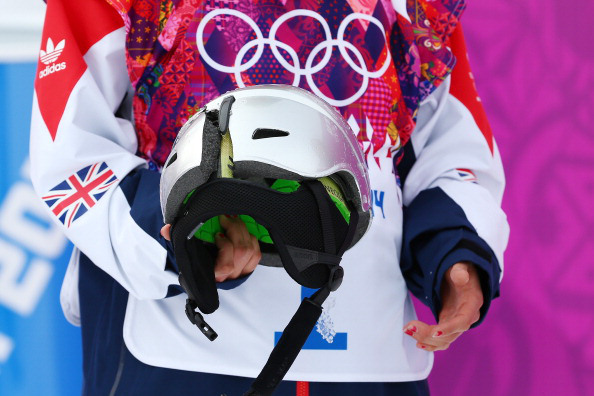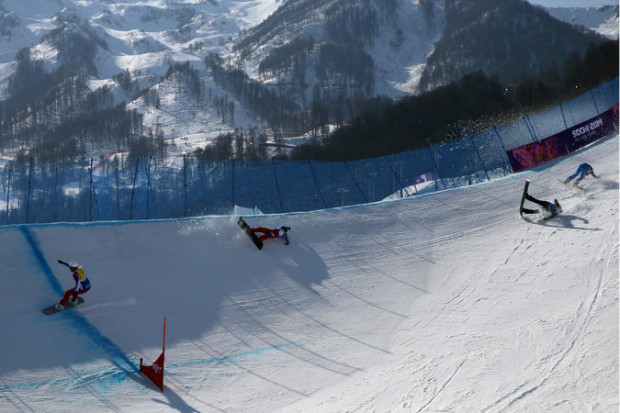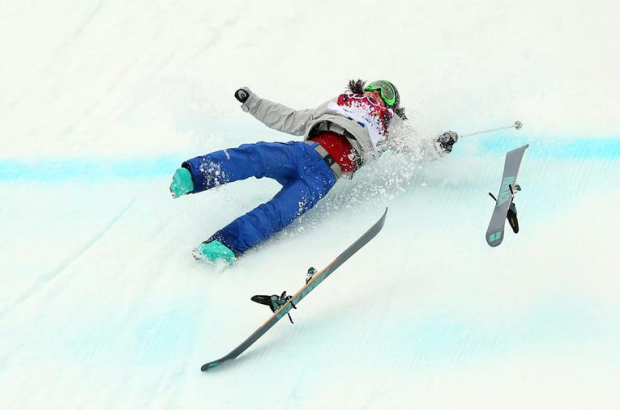
In most Winter Olympic events (downhill skiing, ski jumping, bobsled, luge) women have their own course. At Sochi’s Extreme Park (slopestyle, halfpipe, skier cross) the men and women share the same courses. 16 of the 22 injuries that have occurred in the Extreme Park have been women. Women are having to push their limits and it’s leading to more injuries in women than in men.
The New York Times explains:

The Harder They Fall: Shared Slopes Take Bigger Toll on Women
by The New York Times
Sarka Pancochova, a Czech snowboarder, led the slopestyle event after the first run. On her second trip down the course of obstacles and jumps, she flew through the air, performed a high-arcing, spinning trick and smacked her head upon landing. Her limp body spun like a propeller into the gully between jumps and slid to a stop.
Pancochova was soon on her feet, and the uneasy crowd cheered. Her helmet was cracked nearly in half, back to front.
She was one of the lucky ones, seemingly O.K., but her crash last week was indicative of a bigger issue: a messy collage of violent wipeouts at these Olympics. Most of the accidents have occurred at the Rosa Khutor Extreme Park, the site of the snowboarding and freestyle skiing events like halfpipe, slopestyle and moguls.
And most of the injuries have been sustained by women.
Through Monday night, a review of the events at the Extreme Park counted at least 22 accidents that forced athletes out of the competition or, if on their final run, required medical attention. Of those, 16 involved women. The proportion of injuries to women is greater than it appears given that the men’s fields are generally larger.

But unlike some of the time-honored sports of risk, including Alpine skiing, luge and ski jumping, there are few concessions made for women. For both sexes, the walls of the halfpipe are 22 feet tall. The slopestyle course has the same tricky rails and the same huge jumps. The course for ski cross and snowboard cross, a six-person race to the finish over jumps and around icy banked curves, is the same for men and women. The jumps for aerials are the same height. The bumps in moguls play no gender favorites.
“Most of the courses are built for the big show, for the men,” said Kim Lamarre of Canada, the bronze medalist in slopestyle skiing, where the competition was delayed a few times by spectacular falls. “I think they could do more to make it safer for women.”
Compare the sports with downhill skiing, in which women have their own course, one that is shorter and less difficult to navigate. Or luge, in which female sliders start lower on the track than the men. Or ski jump, in which women were finally allowed to participate this year, but only on the smaller of the two hills. The Olympics have a history — sexist, perhaps — of trying to protect women from the perils of some sports.

But equality reigns at the Extreme Park, even to the possible detriment of the female participants.
J. F. Cusson, ski slopestyle coach for Canada and a former X Games gold medalist, said that his women’s team usually did not practice on jumps as large as the ones the men use, for fear of injury.
“But when they compete, they have to jump on the same jumps, so they get hurt,” he said. “It’s a big concern of mine.”
The most serious injury so far was to Maria Komissarova of Russia, who fractured her spine during training for ski cross. The course is longer and has larger jumps than before. It also has room for six racers, where previous Olympics ran heats of four.
So tell me again why this is a problem aint woman equal and shit? or………..